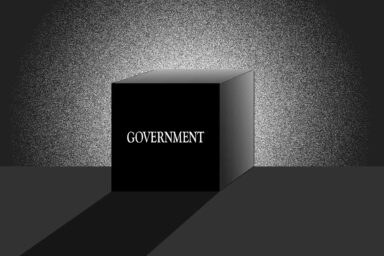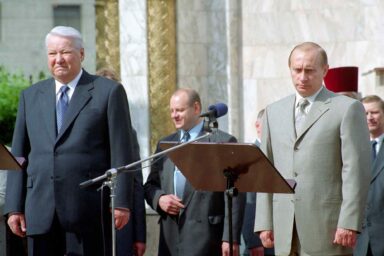LSD, Hookers, Hit Men, and the Top Levels of the CIA
How MK-ULTRA, LSD and Cold War Paranoia Exposed the Deep Politics of the 50s and 60s.
In the 1950s and 60s, at the height of the Cold War, the CIA cornered the market on the world's LSD supply. In this podcast, get a firsthand account from a man who was there.
There is still debate over how involved the government was in the crack-cocaine epidemic that swept America’s urban underbelly in the 1980s. What is indisputable is that in the 50s and 60s, the Central Intelligence Agency (CIA), with direction from its highest leadership, engaged in a program called MK-ULTRA.
MK-ULTRA grew out of the anti-communist obsessions of the Cold War. The CIA would go to Switzerland and corner the market on the world’s supply of LSD — originally to keep it out of the hands of Russia and the KGB.
The cast of characters that the CIA assembled to do this was a rogues’ gallery of sleaze. The agency used hookers to attract clients on whom the drugs were tested in safe house apartments. Later tests were conducted on unsuspecting GIs and students and even on hospital patients.
All this skullduggery was carried out in an effort to develop a drug that would create a real life “Manchurian Candidate.” It might seem like little more than an amusing footnote to a time of Cold War paranoia, were it not for the people murdered and the lives ruined — and the fact that it all happened under the watchful eyes of “honorable men” like Allen Dulles and Richard Helms.
In this week’s WhoWhatWhy Podcast, Jeff Schechtman talks to Richard Stratton. Stratton spent most of the 1980s in federal prison for his own drugs-related crimes. In 1994 he revealed details of MK-ULTRA to an incredulous world.
Today, Stratton is an acclaimed filmmaker and screenwriter, whose films have won praise at the Cannes and Berlin Film Festival. He was the creator and writer for Showtime’s Street Time and he is a former editor of the recreational-drug magazine High Times.
His latest book, Smuggler’s Blues: A True Story of the Hippie Mafia (Arcade Publishing, April, 2016), is a lively recounting of Stratton’s high-wire life, including his long friendship with the author Norman Mailer, and the story of exactly how he managed to get a ton-and-a-half of Lebanese hash through customs in New Jersey.
Click HERE to Download Mp3
Related front page panorama photo credit: Adapted by WhoWhatWhy from Ike Feldman and George White (Spin Magazine / The Frank Olson Legacy Project)
Full Text Transcript:
As a service to our readers, we provide transcripts with our podcasts. We try to ensure that these transcripts do not include errors. However, due to a constraint of resources, we are not always able to proofread them as closely as we would like and hope that you will excuse any errors that slipped through.
Jeff Schechtman: Welcome to Radio Whowhatwhy. I’m Jeff Schechtman.
We have the government and the military to thank for many things; for the creation of the networks that would become the basis of the Internet upon which we’re listening to this. But some things have not been so successful. In the 1980s, for example, many people think that the government was behind the crack-cocaine epidemic that was sweeping America’s urban underbelly. And in the 1960s, the government, more specifically the CIA, as part of the crazy paranoia of the Cold War, gave us LSD. In fact, it cornered the market on this new drug, making sure to beat out the Russians and the KGB. It was seen as a new form of mind control, think the Manchurian candidate. The operation was called MK Ultra. It was run by about as ragtag a group of CIA rogues as one could imagine, but it was always overseen by Allen Dulles and Richard Helms. And the guy that finally broke the story back in 1994, our guest today on Radio Whowhatwhy, was Richard Stratton. Stratton is as colorful as some of the folks he wrote about back then. Now, 22 years after the story first appeared in Spin Magazine, and some 55 years after an army chemist working on the project met an untimely death, we’re going to revisit that story. Originally from a blue-blood New England family, Stratton became a partner in a farm with the celebrated author Norman Mailer. Later he ran a huge marijuana smuggling operation and was arrested in 1982. He became a jailhouse lawyer and an advocate for prison reform. And he’s now an acclaimed filmmaker and screenwriter whose films have won prizes around the world. It is my pleasure to welcome Richard Stratton to Radio Whowhatwhy. Richard, thanks so much for joining us.
Richard Stratton: Well, thank you for having me. It’s my pleasure to participate.
Jeff Schechtman: I want to go back about fifty-five some odd years and talk about what MK Ultra was and how did the government get in the LSD business.
Richard Stratton: Well, you know, I always like to say that it began with an oxymoron, which would be dumb intelligence. The dumb intelligence being that Allen Dulles received a report from a military intelligence agent in Switzerland that the KGB had purchased this new drug from Sandoz Laboratories in Basel, Switzerland in the amount of 10 kilos, which would be, I guess, 50 million doses of LSD, enough to drive a whole half a country bonkers. It was dumped into the water supply. So, Dulles, who at that time along with Richard Helms, who was to become later the director of Central Intelligence, was fascinated with this whole idea of mind control. That men could be turned into virtual robots or Manchurian candidates and set off to do things that might ordinarily be totally against their will or their desires, such as assassinate people and then have no memory of it. And it was believed that LSD might possibly be the mind control agent that they were looking for. During the war, they experimented with a bunch of different chemicals and drugs, mescalin, a very concentrated mixture or tincture of cannabis indica, but nothing really worked. They were looking for truth drugs originally, and then for mind control agents, and when Dulles received this report that the KGB had purchased this huge amount of the LSD drug, which has been touted as the most powerful mind control agent ever discovered by mankind, they were alarmed. Dulles was alarmed and he sent a couple of his agents over to Switzerland to meet with Hoffman, Albert Hoffman, who was the doctor who originally discovered LSD, to purchase every drop of LSD available at Sandoz Laboratories. And when they got there, they were astounded to find that in fact Sandoz had only produced around 40 grams of LSD since it had been discovered, and the agent who had given Dulles the original report was probably not familiar with the decimal system of weights and measures, and had given Dulles a report that was off by a decimal point. So, it was 10 grams that the KGB had purchased rather than 10 kilos. Still, the deal was struck. They bought out all the LSD, and when they got it and brought it back to the United States, they had to figure out, well what are we going to do with this stuff? So they went to a guy by the name of George Hunter White, who had been with OSS during the war, and was very close friends with James Jesus Angleton, the spy master of the CIA, spy master Helms, Dulles, he knew all these guys who were all OSS guys who had gone from wartime OSS service into the CIA. George, however, had gone back to the Federal Bureau of Narcotics. He was one of Harry Anslinger’s top men, and a drug warrior par excellence. So, who better to get the job to test LSD on unwitting human guinea pigs but an agent with the Federal Bureau of Narcotics. Enter George Hunter White in his alias as Morgan Hall, and he rented himself an apartment in Greenwich Village on Bedford Street. And from that apartment he would venture out into the streets of New York City’s Greenwich Village, moonlighting for the CIA and lure people back to the apartment, then dose them with massive doses of LSD 25, pure Sandoz LSD 25, and then sit behind a one-way mirror where he could watch the goings on in his apartment. He sat on a portable toilet because he didn’t want to have to get up and relieve himself. And George was quite the drinker. He would have his own batch of Nick’s Martinis there as he would observe what happened to these poor folks who were brought in from various clubs and bars in the Village and then dosed with acid, and George would make his notes and report back to the CIA. So, that was how it all began.
Jeff Schechtman: What did he start to find out? What did he see as the reaction to this, number one? And number two, the other thing that was pretty amazing about George White is that he wanted to try everything himself as well.
Richard Stratton: Yeah. Well, that’s one of the few things that I think I admire about George. I mean, I have a very, kind of complex relationship, having studied this guy’s career. But, I will give him credit for that; that he didn’t do anything, he didn’t test anything on anybody that he didn’t first test on himself. But, as they say about LSD: LSD favors the prepared mind. If you know you’ve taken acid and you’re going on a trip, it’s one thing. If, however, you think you just had a martini with somebody, and the next thing you know, you’re having hallucinations and really feel like you’re losing your mind, it’s quite another thing altogether. So, George, I think, what he ultimately came to believe about LSD was, first of all, that it was unpredictable. He, in fact, named it “Stormy,” that was his nickname for it because he never knew what you were going to get. You know, one person would take it and have an incredible experience and have visions of splendor and get off on it, and others would have a very bad trip and freak out. So you never knew what you were going to get, and you certainly never knew what you were going to get with George because a lot of times he would participate in the activities himself. So, their original idea, which was to try to see if it was valuable as a truth serum, had some positive results in that people tended to open up and become [inhibited?] and talk about stuff that they might ordinarily have kept secret, but it was too unpredictable for that. Ultimately, they began to see it more as an offensive weapon that could be slipped to a head of state who was about to give a speech, someone that they were hoping to ridicule and that was ultimately how they did use it. They used it on a couple of people. And, ultimately they were going to try to defrock or take out Fidel Castro by soaking a box of cigars; a box of his favorite cigars with acid and then hoping that they could send him on a trip.
Jeff Schechtman: One of the other strange characters in this story is a guy that became George White’s partner. A guy by the name of Ike Feldman. Tell us about him,
Richard Stratton: Well, Ike, fortunately for me, Ike was the only person still alive who had actually participated in the MK Ultra experimentation. When I started working on the story, how I got involved in the story in the first place was that Bob Guccione Jr., who was then the editor of Spin Magazine, called me in one day and said, “Listen, we’ve been hearing these stories for years about how it was the CIA who introduced LSD to the United States.” Timothy Leary had been talking about it, Allen Ginsberg had written poetry about it. He said, “I want you to find that story for me and see if you can get someone who actually was involved in it. Either as a subject who was tested by it or somebody who was involved in the testing. Get me a first person interview.” So I thought, well, I don’t know quite how I’m going to go about this, but because of my own history in the drug underworld, I had some connections. I went and found out, found first of all the name of George’s partner. This guy Ira “Ike” Feldman, who was a Federal Bureau of Narcotics agent, as was George, and had worked closely with George. I then went to a private investigator I knew here in New York City who had been named “New York City Narcotics Agent” before he became a private investigator. And I asked him if he remembered Ike Feldman. He said, “oh yeah, Ike Feldman! That guy was a maniac. He and George White, they were, you know, these crazy federal agents who were involved in all kinds of stuff.” I said, “Can you find out if this guy is still alive, and if so where he is?” And about a week later, he located Ike who’s then living out in Long Island, was probably in his late seventies or early eighties, and I contacted him and asked him for an interview. Now Ike, ever since George had died, he kind of kept a very low profile, had never spoken to any journalist or anybody who was looking for his story. But he agreed to speak with me mainly because of where I was coming from, having been convicted of drug offenses, keeping my mouth shut, going to prison, doing the time, refusing to rat on people. He had a certain amount of grudging respect for me. So I met with Ike out in Long Island at a hotel and he launched right into the story, showed me he still had ampoules, tiny football-shaped ampoules of pure LSD 25, showed me how they used to crack the top off and squirt it into people’s drinks, explained to me how working for George he became a so-called CIA pimp, where he would go out and bring these hookers back to the apartment and dose them with acid. And then later, actually after they moved the whole operation to San Francisco after Frank Olson went out the window here in New York, which we’ll talk about. It became more of they wanted to see how they could also use sex, and hookers to ply information out of potential subjects that they were going to dose with drugs and then use these hookers to get information out of them.
Jeff Schechtman: The extent to which they tested this, even went beyond just the people that George White was bringing back to this apartment and that Ike Feldman brought back to the apartment. They were testing it in hospitals and universities, they were testing it on GIs, they didn’t stop the testing on this for a long time.
Richard Stratton: No, they tested it in prison. They tested it in a lot of prisons in Kentucky; in the narcotics facility that they had in Lexington, Kentucky. The infamous Boston gangster Whitey Bulger actually had participated in tests in Atlanta, in a penitentiary there and got ten years knocked off his sentence for agreeing to be given massive doses of LSD. So yeah, they were testing it all over the place. They really had, for years and years, beliefs that they could use this drug either offensively or defensively. Another part of it was that they decided that they wanted to be able to prepare their agents in case their agents were dosed with acid. So it became what they call trying to develop enlightened agents, so that agents who were given the drug would know that they had taken the drug and therefore protect their secret. You have to wonder, if in fact, they were just having a ball with this. You know, partying with it, I mean they were dosing each other at headquarters in Washington. Then, as part of this, there was a retreat that took place at a place called Deep Creek Lodge, I think it is in Maryland if I’m not mistaken, where Dr. Sidney Gottlieb, who was the kind of mad scientist that was the overseer of all these experiments, dosed all of the scientists who were there. He put some acid into the Cointreau, the after dinner drinks without telling these guys, and then he passed out the drinks. And one of the scientists there was a fellow by the name of Frank Olson, who had been working out of Fort Detrick doing a lot of very, very high, top secret experiments with various biological and chemical agents that they were developing as offensive weapons. And Olson had a complete psychotic snap with reality. He started babbling about “I have made a terrible mistake,” he began to question what he had done in his career, and became, as far as the CIA was concerned, a real risk. In fact, from what I have later learned after I read this fantastic book called A Terrible Mistake by Hank Albarelli about the death of Olson, was that Olson had already been talking about stuff he had been involved in, experiments he had been involved in, and was having second thoughts about him, having a guilty conscious in fact, and the CIA became very concerned and, according to Albarelli, dosed him with the intention of trying to find out just how much he had been talking about what he had been doing at Fort Detrick. The upside of all of this was that Olson never came back from that trip. He was depressed, he was having hallucinations. He went home and his wife and the family became concerned. Ultimately the CIA took him to New York to visit a psychiatrist who was connected to the CIA. Dr. Abramson, who had done a bunch of LSD testing himself. Abramson suggested that they give him barbiturates and alcohol and try to get him to pass out to see if he could sleep it off, but that didn’t work either. They ultimately took him to a hotel here in New York City across from Penn Station and Olson went flying out of a tenth floor window and plummeted to his death on the sidewalk. Now, for years, that was passed off to the family as a suicide without even telling the family of the fact that Olson had been dosed with LSD. The dosing of Olson came out in the ‘70s at the Senate hearings into the CIA and the Olson family was given money and apologies by the president, I think it was President Gerald Ford at the time and told “we’re awfully sorry about what happened to your husband and father.” But then, after my article came out, it was actually Ike Feldman who said to me “I don’t know if he jumped out of the window or if they threw him out of the window.” And then we did a news conference where he went further and said “yeah, yeah they threw that guy out of the window.” And it was his statement to me that somehow got… Somebody read the article and contacted Olson’s son, Eric Olson, who then called me, and said “listen, I read this article and I want to get in touch with this guy, Ike Feldman.” I gave him Ike’s number. Eric Olson got in touch with Feldman, and then Feldman repeated to him what he told me: “yeah your father didn’t commit suicide. They threw him out that window.” So that began the whole investigation into the death of Frank Olson. What happened there was that Eric Olson was able to get his father’s remains exhumed, and they actually got a couple of prosecutors in the Morgenthau’s office here in New York City to investigate this as a possible homicide. When they dug the bones up, they brought this guy, Starrs, who was a forensic pathologist. He did an examination of Olson’s remains and concluded that there was blunt trauma to the skull that was not consistent with his having jumped or fallen out the window, but was consistent with him having been hit over the head with something like a blackjack or baseball bat or something and then thrown out the window. And that, as I say, began this homicide investigation which took place in 1953, and this investigation was over 25 years old. So it didn’t result in a whole lot. However, this guy Hank Albarelli, in his book A Terrible Mistake: The Murder of Frank Olson, he actually identified the two men who threw Olson out the window, and they were men who worked directly for George Hunter White. George probably would’ve done it himself, but he was out in California at the time, his mother had died, he was at her funeral. But he gave the job to a couple of his informants, a couple of fascinating characters by the name of Jean-Pierre Lafitte, who I believe was a Corsican, and his partner, not Corsican, by the name of Spirito, who were informers for the Federal Bureau of Narcotics but also were contract agents who worked for George and for the CIA in particularly dangerous and wet operations, basically assassinating people. They were responsible for throwing Frank Olson out the window, so it was clearly a murder. It was a disposal that was done on behalf of the Central Intelligence Agency to shut this guy out.
Jeff Schechtman: During all those experiments, and it really became clear that the LSD wasn’t going to be this miracle Manchurian candidate-like drug, what and who kept driving the train for MK Ultra? Who kept pushing this forward?
Richard Stratton: Well, there’s a few different theories about that, but if there was one person that I would have to say was probably the driving force behind it, it would be Rich Helms. Helms with Sidney Gottlieb, who was the scientist who was in charge of the CIA Technical Services Division. Gottlieb was an interesting character himself. He was a chemist, and he had a doctorate in chemistry. New York guy, not typical of the sort of waspy, Ivy-League elite who ran the CIA, guys like Dulles and Helms, but Gottlieb and Helms together were the ones who really were the driving forces behind the MK Ultra experiments. And in the ‘70s, when the Senate and Congress started to look into the CIA’s activities, when Watergate sort of ripped the bill back on what the CIA had been involved in, it was Helms who ordered Gottlieb to destroy all the documents that were in existence on the MK Ultra experiments. Gottlieb was probably 90% successful in doing that, however, there are, and still exist, a bunch of documents that Gottlieb, for whatever reason, was not able to destroy, that have led people to expose exactly what was going on with MK Ultra. So I have to say it was Richard Helms. Helms was fascinated by the whole idea of the MK Ultra Manchurian Candidate, and you know, there’s differing theories about this. Some people would claim Lee Harvey Oswald was a Manchurian Candidate. The interesting thing about Oswald was that he was stationed at Atsugi Airforce Base, I think in Japan, where in fact, they were doing experiments with LSD at Atsugi during that time. So who knows, you know, maybe according to Ike Feldman, he claims that it was successful, that they were able to create Manchurian Candidate. And, you know, who knows, maybe could it be that Oswald was a Manchurian Candidate? That, you know, these other assassins that we’ve seen come out, they’re all curiously similar in ways. You know, these kind of loner characters who fortunately for the media and for law enforcement keep diaries, that they talk about how they’re going to kill people like John Lennon or Martin Luther King. Or you get a guy like Sirhan Sirhan. Now where did Sirhan Sirhan come from? I mean, he claims he has no recollection of the night that he supposedly killed Bobby Kennedy. That’s the other thing that they wanted to do with the Manchurian Candidate was to be able to control him or her to do their assassinations and then have no memory of the event. So, who knows, maybe it was actually successful, and if these guys did create Manchurian Candidate, and that those Manchurian Candidates were the ones who in fact killed these leaders along the way; JFK, RFK, MLK and John Lennon, who knows, it’s possible. I’m not going to say that that’s not what happened.
Jeff Schechtman: You mentioned congressional investigations that went on into MK Ultra. Why did they really not turn up very much?
Richard Stratton: Well, probably because, and this is another theory that’s out there, I mean, if you read this excellent book that came out recently called The Devil’s Chessboard: Allen Dulles, the CIA, and the Secret History of America, something along those lines, by a guy named David Talbot. It’s a fantastic book. If you believe that book and I think that it is pretty well documented, Allen Dulles was the first civilian director of central intelligence along with his brother John Foster Dulles who was secretary of state during the Eisenhower Administration, and his sister who was also in the state department and had a very powerful job as the, I think she had the German Desk, or whatever. Dulles is a fascinating character. Dulles may have been the most powerful force in American politics, or American foreign policy and domestic policy after World War II, by his control of the CIA and his brother’s control of the state department. Eisenhower was seen as a very popular president but not a very powerful political leader, and probably was more under the control and under the thumb of the Dulles brothers than he was in control of his own government. So, could these guys really have been the ones who were behind all of this and who kept it all going and who were able to cover it up? That would be, I think the theory that’s most believable at this point. Dulles in fact was the one who controlled the Warren Commission looking into the assassination of JFK, was able to control the people who sat on the commission and the evidence that was brought to the commission. So, you know, the Dulles brothers and the CIA had much more power than any administration of the government as far as what was going on nationally and what was going on internationally. And you know, you spoke earlier in the introduction about the government involvement in crack-cocaine, or the government’s involvement, I think it’s a misnomer to say “the government.” What it was and what it continues to be, no doubt, is that there are these cabals that exist within segments of the government – whether it be the CIA, or whatever. There are these groups of very powerful men who get together and decide that their agenda is going to take precedence, and they are able, because of their power, when you have like guys like Dulles, or guys that work within the administration, they are able to shake the direction of American politics. Now this becomes particularly scary when you think about where we’re at right now in the race for the American presidency. If you think of who our two frontrunners are, it gets pretty scary to think of how they might be manipulated by these unbelievably powerful cabals that emanate from Wall Street, that emanate from other areas of international control over finances and world politics. These guys have much more power, and this power goes from administration to administration to administration. And it becomes frightening when we think of who might be sitting in the White House over the course of the next four to eight years.
Jeff Schechtman: You talked earlier about how, originally, George White and Helms cornered the market on LSD that was made by this lab in Switzerland. Ultimately, that company was bought by an American company, they bought up all of their LSD. How did LSD move into the mainstream and into the popular culture; into people like Timothy Leary and others?
Richard Stratton: Well, after they made this deal with the Sandoz company, in fact, part of that deal was they bought all the LSD that they had manufactured up to that point, and they also made a deal to contract for every drop of LSD that was produced thereafter with the caveat that the KGB get none of it because they were very concerned about LSD getting into the hands of KGB. So then, however, the Eli Lilly Company in this country came up with a synthetic LSD. They were able to actually create LSD and make it available as they put in their memo to the CIA in tonnage quantities. So, the CIA, after getting the original, the pure stuff from Sandoz, was able to get the synthetic LSD from Eli Lilly, and that’s where they really began the experimentation that became so widespread, it’s unbelievable when you think about it. It was at universities, it was in, as we said, in prisons, it was in Canada and it was through Timothy Leary at Harvard. Ken Kesey was working in a mental institution out there in California before he had even written One Flew Over the Cuckoo’s Nest, and he volunteered to be tested with LSD. So, the LSD then found its way into the counterculture. I think what’s really fascinating about this is that their effort to create Manchurian Candidate in fact backfired and created the countercultural movement and the anti-war movement, and the youth movement of the ‘60s and ‘70s that turned this country upside down. It really had just the opposite effect of what they wanted. They seemed to want to create these mental zombies that they could control, and what they in fact created was these freaks that nobody could control. To me, that’s so ironic and so fascinating, and so interesting and so American in its way. He started along down one path, but he’d end up in another entirely –
Jeff Schechtman: And in fact Timothy Leary credits the CIA.
Richard Stratton: Indeed, he does. Indeed, he does, because he knows that that original acid that he got up there at Harvard to test on himself, he being like George White, you know, what’s good for the goose is good for everybody else, he tested it on himself first, and of course that began this whole, kind of revolution in consciousness that we saw back in those days, and ultimately, which is kind of even more interesting, you know, was the CIA Watergate guy that busted Leary up there in upstate New York, who, you know, ended up becoming part of Watergate. So it’s fascinating how all this stuff is related and how it all goes back to George White and the MK Ultra experiments.
Jeff Schechtman: Richard Stratton, I thank you so much for spending time with us here on Radio Whowhatwhy.
Richard Stratton: Thank you, it’s been my pleasure. It’s always fun to talk about this stuff. It’s mind boggling, but at the same time, as I say, it’s America’s secret history, and the more we find out about it, the more we need to know because according to Ike Feldman, you know it’s still going on to this very day.
Jeff Schechtman: Richard, thank you very much.
Richard Stratton: Thank you.
Jeff Schechtman: And thank you for listening and joining us here on Radio Whowhatwhy. I hope you’ll join us next week for another Radio Whowhatwhy podcast. I’m Jeff Schechtman. If you liked this podcast, please feel free to share it and help other people find it by rating and reviewing it on iTunes. You can also support this podcast and all the work we do by going to whowhatwhy.org/donate





